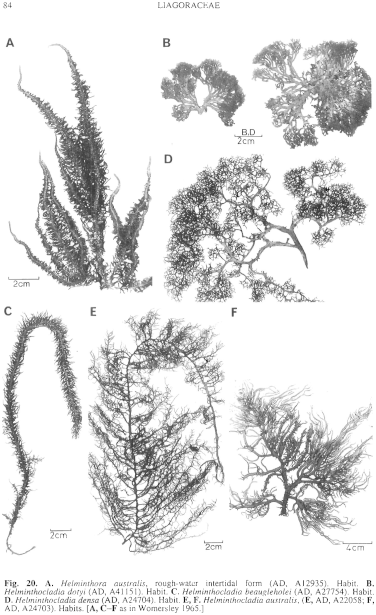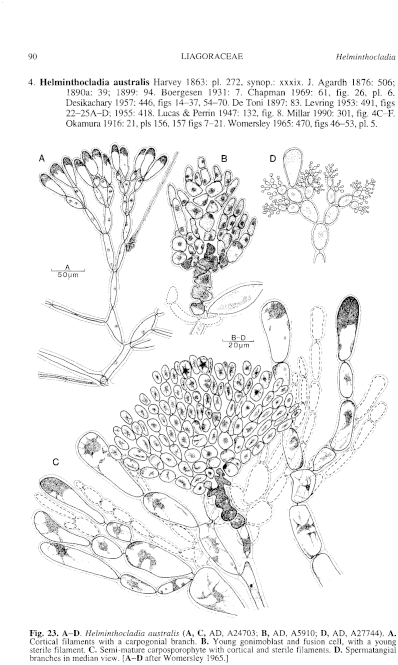|
|
|
|
|
|||||||||||
|
Electronic Flora of South Australia Species Fact Sheet
Phylum Rhodophyta – Class Florideophyceae – Order Nemaliales – Family Liagoraceae
Selected citations: J. Agardh 1876: 506; 1890a: 39; 1899: 94. Boergesen 1931: 7. Chapman 1969: 61, fig. 26, pl. 6. Desikachary 1957: 446, figs 14–37, 54–70. De Toni 1897: 83. Levring 1953: 491, figs 22–25A–D; 1955: 418. Lucas & Perrin 1947: 132, fig. 8. Millar 1990: 301, fig. 4C–F. Okamura 1916: 21, pls 156, 157 figs 7–21. Womersley 1965: 470, figs 46–53, pl. 5.
Synonyms
Heiminthora tumens J. Agardh 1890a: 41. De Toni 1897: 85. Lucas 1935: 215. Lucas & Perrin 1947: 133.
Helminthocladia tumens (J. Agardh) J. Agardh 1899: 95. De Toni 1924: 84.
Thallus (gametophyte) (Fig. 20E, F) brown to purple, 10–40 cm high, with one to many terete, irregularly and usually profusely branched axes 2–10 mm in diameter below, branches (0.5–) 1–3 mm in diameter above; older axes and branches sometimes denuded below. Holdfast discoid, 2–5 mm across; epilithic. Structure of a medulla of moderately robust filaments, 8–20 µm in diameter near branch apices, increasing to 30–40 µm in diameter in older parts, and a cortex (Fig. 23A) 100–200 (–300) µm broad, of elongate to ovoid (when mature) cells, subdichotomously branched every 1–4 cells in inner cortex, usually at every cell in outer cortex; terminal cells of cortical filaments relatively large (Fig. 23A), often palisade-like [when mature (25–) 30–60 µm long and (10–) 15–30 µm in diameter], ovoid to clavate, often markedly larger than the subterminal cells; inner cortical cells in older parts of thallus may equal or even exceed the terminal cells in size; rhodoplasts irregularly stellate, each with a central pyrenoid (Fig. 23C); hairs often present on subterminal cells near branch apices.
Tetrasporophyte unknown.
Reproduction: Sexual thalli dioecious. Carpogonial branches (Fig. 23A) 3-celled, curved, laterally situated on inner cortical cells; carpogonium conical. Zygote dividing more or less obliquely, cutting off 2–4 apical segments (Fig. 23B) which initiate the much branched compact gonimoblast (Fig. 23C), with terminal ovoid carposporangia (10–) 15–25 µm long and 6–11 µm in diameter. Carposporophyte within the outer cortex, 100–250 µm across in surface view. Following fertilization the carpogonial branch cells fuse (Fig. 23C) and in the mature carposporophyte a distinct fusion cell is normally present, involving at least the old carpogonial branch cells and usually the basal cells of the gonimoblast. Sterile post-fertilization filaments (a few cells long) develop from the supporting cell and the adjoining cells (Fig. 23B, C), and grow irregularly around the old carpogonial branch; also cells of adjacent cortical filaments produce new erect filaments which form an involucre around the carposporophyte (Fig. 23C) and appear similar to the cortical filaments but less mature (i.e. the end cells are not enlarged until much later). The abundance of these involucral filaments varies from very few to numerous in different specimens. Spermatangial clusters (Fig. 23D) densely paniculate, borne on scattered subterminal cells of cortical filaments, each cluster comprising 2–4 axial cells bearing radially 1–3 orders of cells; the outermost acting as spermatangial initials and cutting off 1–3 spherical to ovoid spermatangia 1–2 µm in diameter.
Type from Fremantle, W. Aust. (G. Clifton); in Herb. Harvey, TCD.
Selected specimens: Tantabiddy Creek, Exmouth, W. Aust., low eulittoral pools (Cambridge, 21.viii.1979; AD, A51812). Port Denison, W. Aust., inner reef (Womersley, 30.viii.1947; AD, A5910). West Beach, S. Aust., drift (Womersley, 10.i.1959; AD, A22058). Victor Harbor, S. Aust., upper sublittoral (Womersley, 28.i.1961; AD, A24703). Pennington Bay, Kangaroo I., S. Aust., rear reef (Womersley, 29.viii.1948; AD, A8729). Bridgewater Bay, Vic., on rocks (Beauglehole 745, 21.xi.1961; AD, A27744). Sorrento, Vic., upper sublittoral in bay (Womersley, 13.i.1981; AD, A51982). Walkerville, Vic., just below low tide (Sinkora A1493, 21.ii.1972; AD, A42294). Bluestone Bay, Freycinet Pen., Tas., 6 m deep (Brown, McGeary & Womersley, 4.xi.1982; AD, A56267).
Distribution: New Zealand (Bay of Islands to Stewart I.); Japan; South Africa; California. Exmouth, W. Aust., around southern Australia and Tasmania to Coffs Harbour, N.S.W.; Lord Howe I.
Taxonomic notes: This is a common species in areas of moderate to slight wave action, though patchy in its occurrence. In southern Australia it occurs during the summer but on subtropical W. Aust. coasts it has been recorded during winter.
Relationships with species from Europe, South Africa, California and Japan were discussed by Womersley (1965, p. 473), and further comparisons are still needed.
References:
AGARDH, J.G. (1876). Species Genera et Ordines Algarum. Vol. 3, Part 1 - Epicrisis systematis Floridearum, pp. i-vii, 1–724. (Weigel: Leipzig.)
AGARDH, J.G. (1890a). Till algemes systematik. Acta Univ. lund. 26(3), 1–125, Plates 1–3.
AGARDH, J.G. (1899). Analecta Algologica. Cont. V. Acta Univ. lund. 35, 1–160, Plates 1–3.
BOERGESEN, F. (1931). Some Indian Rhodophyceae especially from the shores of the Presidency of Bombay. Kew Bull. 1931(1), 1–24, Plates I, H.
CHAPMAN, V.J. (1969). The marine algae of New Zealand. Part III: Rhodophyceae. Issue 1: Bangiophycidae and Florideophycidae (Némalionales, Bonnemaisoniales, Gélidiales). (Cramer: Germany.)
DE TONI, G.B. (1897). Sylloge Algarum omnium hucusque Cognitarum. Vol. 4. Florideae. Sect. 1, pp. 1–388. (Padua.)
DE TONI, G.B. (1924). Sylloge Algarum omnium hucusque Cognitarum. Vol. 6. Florideae. (Padua.)
DESIKACHARY, T.V. (1957). Helminthocladia from India and New Zealand. J. Indian Bot. Soc. 36, 441–456, Plates 15, 16.
HARVEY, W.H. (1863). Phycologia Australica. Vol. 5, Plates 241–300, synop., pp. i-lxxiii. (Reeve: London.)
LEVRING, T. (1953). The marine algae of Australia. I. Rhodophyta: Goniotrichales, Bangiales and Némalionales. Arkiv för Bot. Ser. 2, 2, 457–530.
LEVRING, T. (1955). Contributions to the marine algae of New Zealand. I. Rhodophyta: Goniotrichales, Bangiales, Némalionales and Bonnemaisoniales. Arkiv för Bot. Ser. 2, 3, 407–432.
LUCAS, A.H.S. & PERRIN, F. (1947). The Seaweeds of South Australia. Part 2. The Red Seaweeds. (Govt Printer: Adelaide.)
LUCAS, A.H.S. (1935). The marine algae of Lord Howe Island. Proc. Linn. Soc. N.S.W. 60, 194–232, Plates 5–9.
MILLAR, A.J.K. (1990). Marine Red Algae of the Coffs Harbour Region, northern New South Wales. Aust. Syst. Bot. 3, 293–593.
OKAMURA, K. (1916). Icones of Japanese Algae. Vol. 4 (2), pp. 20–40, Plates 156–160.
WOMERSLEY, H.B.S. (1965). The Helminthocladiaceae (Rhodophyta) of southern Australia. Aust. J. Bot. 13, 451–487, Plates 1–7.
The Marine Benthic Flora of Southern Australia Part IIIA complete list of references.
Publication:
Womersley, H.B.S. (14 January, 1994)
The Marine Benthic Flora of Southern Australia
Rhodophyta. Part IIIA, Bangiophyceae and Florideophyceae (to Gigartinales)
Reproduced with permission from The Marine Benthic Flora of Southern Australia Part IIIA 1994, by H.B.S. Womersley. Australian Biological Resources Study, Canberra. Copyright Commonwealth of Australia.
Illustrations in Womersley Part IIIA, 1994: FIGS 20E, F, 23.

Figure 20 enlarge
Fig. 20. A. Helminthora australis, rough-water intertidal form (AD, Al2935). Habit. B. Helminthocladia dotyi (AD, A41151). Habit. C. Helminthocladia beaugleholei (AD, A27754). Habit. D. Helminthocladia densa (AD, A24704). Habit. E, F. Helminthocladia australis, (E, AD, A22058; F, AD, A24703). Habits. [A, C–F as in Womersley 1965.]

Figure 23 enlarge
Fig. 23. A–D. Helminthocladia australis (A, C, AD, A24703; B, AD, A5910; D, AD, A27744). A. Cortical filaments with a carpogonial branch. B. Young gonimoblast and fusion cell, with a young sterile filament. C. Semi-mature carposporophyte with cortical and sterile filaments. D. Spermatangial branches in median view. [A–D after Womersley 1965.]

|
Email Contact: State Herbarium of South Australia |

|